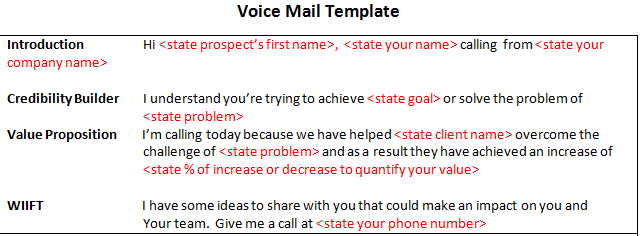1 min read
Most Staffing Firms are Not Built to Scale, But to Survive
Most staffing firms don’t struggle to scale because their teams aren’t working hard. They struggle because they don’t have a real go-to-market...
5 min read
![]() Dan Fisher
:
Jan 27, 2017 9:25:39 AM
Dan Fisher
:
Jan 27, 2017 9:25:39 AM

 According to Jill Konrath, sales calls go into voicemail 97% of the time. Suffice it to say, sales professionals better be pretty darn good at leaving sales voicemail messages. Heck, sales professionals have as little as 10 seconds to get the attention of the prospect before they hit the delete button!
According to Jill Konrath, sales calls go into voicemail 97% of the time. Suffice it to say, sales professionals better be pretty darn good at leaving sales voicemail messages. Heck, sales professionals have as little as 10 seconds to get the attention of the prospect before they hit the delete button!
So what is the key to leaving a successful sales voice mail message? Tons and tons of practice for starters. That is certainly not a novel idea yet most salespeople struggle with leaving sales voicemail messages because they don't take the time to practice and instead simply leave the same ineffective message over and over.
Download Now: Top Sales Prospecting Techniques That Book More Meetings
Through personal experience and working with thousands of IT staffing sales reps over the years I have identified some best practices. Below are some tips to leaving sales voicemail messages that generate call-backs
Practice, Practice, Practice. And Practice Some More!
If you follow my blog than you know that I'm a strong believer in practicing your craft. Just like sales reps need to practice by role playing, they also must practice leaving sales voice mail messages to improve performance This means creating a structured practice routine that provides opportunity for repetition and immediate constructive feedback. Here are a few ideas to keep in mind.
Before you start making your dials you must decide on what your goal is for the day. With leaving sales voicemail messages there are several things you can work on. I suggest you keep it simple and focus on one component. For example, you could focus on your tonality (remember 93% of communication is not what you say but how you say it and deliver the message). Practicing your tonality may include the use of inflection points in your voice or passion and enthusiasm in your tone. Another key element to sales voicemail messages is practicing the timing or the length of your message. You only have so much time to nail your message. That is another element you could focus on. Finally there is the message itself. You can work on crafting different messages for different buyer personas and for the different stages of the sales cycle in which find yourself in with each of your prospects or customers.
Leaving the Actual Sales Voicemail Message
You may call me "old-school" but I suggest you script out each sales voicemail message. You only have one chance to nail it (or let your prospect delete it). Remember, your sales voicemail message must be tailored and customized to each specific buyer which means in all likelihood that you need to physically write it out.
Second, if you haven't memorized it then you need to read it from from your script. But before you do, leave your message in your personal voice mailbox so that you can hear it yourself. You can also leave the message for your manager or with a friend or peer. Trust me when I say that sales professionals who "wing" their voicemail messages rarely get their messages returned. You want to practice on yourself before you leave the actual message with your prospect to make sure you don't sound like you're reading from a script.
Playback Your Sales Voicemail Message
These days most phone systems offer you the option to play back and listen to your message (or delete it and re-record) before hanging up. I suggest you take advantage of this feature and do a self-evaluation. Think of listening to and evaluating your voicemail messages like a professional quarterback studies film from the previous week's game. Listen closely to what you say, your tonality and the length of your message. Your recordings will give you very specific feedback on what you need to improve on. Here are some sample criteria in which you could benchmark your sales voicemail messages.
The more you do this the quicker you will improve. You can also record your voicemail messages with your smart phone if the phone system will not record it for you.
Tonality
Remember, the goal of any sales voicemail message is to generate a call-back. This part can't be overstated and that is you must have passion and enthusiasm in your tonality. In order for your prospects to hear that passion and enthusiasm you will need to have a smile on your face. Believe me, I understand how mundane it is to make 100+ dials in a day and get zero prospects on the phone. But your prospects are listening to and hearing your attitude come through your voicemail message. Think of your tonality as an extension of your attitude.
Sales Voicemail Message Methodology Template
A methodology is not the same thing as a script. Your script is what you will say, the physical words that come out of your mouth. Your methodology for leaving a sales voicemail message is more of an outline of how you structure your voicemail message. Here is a sample sales voicemail methodology that I have created.

What I have learned from leaving hundreds of thousands (maybe millions?) of sales voicemail messages is that in order to generate a call-back the sales rep must:
To help you put this all together and make sure that it make sense I also suggest you download my eBook, How to Build an Impactful Value Proposition. This will walk you through step by step how to build your value proposition. In order speak with confidence and like a thought leader you need to have a value proposition. Following my step by step plan for building a value proposition enables IT staffing sales professionals to truly differentiate themselves and gives them the confidence they need (and must have) to speak like a thought leader.
Sales Call Planning Research
As you review my sales voicemail message methodology you can see that it clearly requires the sales rep to conduct some sales call planning. The difference between a cold voicemail and a warm voicemail is your research. If your prospect doesn't feel that you understand his or her role and their business than you have a 0% chance of getting your message returned. You need to find a connection between your prospect's business (and projects they're working or goals they're trying to achieve/problems they're trying to solve) and your service offering.
Short and Simple
Try to keep your sales voicemail messages to 30 seconds or less. Also, don't reference previous voice mail messages that failed to generate a call-back. And research shows that the best time to leave a voicemail message is between 6:45 AM and 8:00 AM local time and 4:30 PM and 6:30 PM local time. Yes, you need to get in early and work late. These are the hours your prospects work!
Data Science
Finally, one thing that I have learned over the years (from following my friends over at Hubspot) is that they apply science to just about everything they do (which makes since many of their senior leaders came from MIT). The only way you will figure out how to "leave the perfect message" and increase your call-backs is to evaluate your messages and track your success rate. This means you need to do A/B testing with your sales voicemail messages. You need to track which messages you left for which prospects and track your call-back return rate. As you practice and score your sales voicemail messages, you’ll start to figure out what is effective and working and what is not working. Learn from your data and experience and iterate accordingly until you perfect the art of leaving a sales voicemail message.
What is working for you regarding sales voicemail messages? What do you find most challenging about leaving sales voicemail messages? Let's start a conversation in the comments section below.

1 min read
Most staffing firms don’t struggle to scale because their teams aren’t working hard. They struggle because they don’t have a real go-to-market...

In my previous post, How to Prevent Unexpected Contract Terminations, I shared how systemizing consultant and client check-ins at key milestones...

About a year ago, I was serving as the fractional revenue leader, managing sales and recruiting for a client.